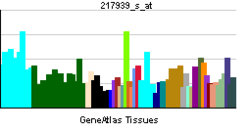AFTPH
| Clathrin-binding box of Aftiphilin |
|---|
| Identifiers |
|---|
| Symbol |
Clathrin_bdg |
|---|
| Pfam |
PF15045 |
|---|
|
|
Aftiphilin is a protein that in humans is encoded by the AFTPH gene.[3][4][5][6]
Aftiphilin forms a stable complex with p200 and synergin gamma.[4][5] The protein contains a clathrin box, with two identified clathrin-binding motifs, and is involved in vesicle-trafficking.[7] The protein is found in many eukaryotes.
References
- ↑ "Human PubMed Reference:".
- ↑ "Mouse PubMed Reference:".
- ↑ Mattera R, Ritter B, Sidhu SS, McPherson PS, Bonifacino JS (Feb 2004). "Definition of the consensus motif recognized by gamma-adaptin ear domains". J Biol Chem. 279 (9): 8018–28. doi:10.1074/jbc.M311873200. PMID 14665628.
- 1 2 Hirst J, Borner GH, Harbour M, Robinson MS (Apr 2005). "The aftiphilin/p200/gamma-synergin complex". Mol Biol Cell. 16 (5): 2554–65. doi:10.1091/mbc.E04-12-1077. PMC 1087257
 . PMID 15758025.
. PMID 15758025. - 1 2 Burman JL, Wasiak S, Ritter B, de Heuvel E, McPherson PS (Apr 2005). "Aftiphilin is a component of the clathrin machinery in neurons". FEBS Lett. 579 (10): 2177–84. doi:10.1016/j.febslet.2005.03.008. PMID 15811338.
- ↑ "Entrez Gene: AFTPH aftiphilin".
- ↑ Lui-Roberts WW, Ferraro F, Nightingale TD, Cutler DF (December 2008). "Aftiphilin and gamma-synergin are required for secretagogue sensitivity of Weibel-Palade bodies in endothelial cells". Mol. Biol. Cell. 19 (12): 5072–81. doi:10.1091/mbc.E08-03-0301. PMC 2592662
 . PMID 18815278.
. PMID 18815278.
External links
Further reading
- Maruyama K, Sugano S (1994). "Oligo-capping: a simple method to replace the cap structure of eukaryotic mRNAs with oligoribonucleotides.". Gene. 138 (1–2): 171–4. doi:10.1016/0378-1119(94)90802-8. PMID 8125298.
- Bonaldo MF, Lennon G, Soares MB (1997). "Normalization and subtraction: two approaches to facilitate gene discovery". Genome Res. 6 (9): 791–806. doi:10.1101/gr.6.9.791. PMID 8889548.
- Suzuki Y, Yoshitomo-Nakagawa K, Maruyama K, et al. (1997). "Construction and characterization of a full length-enriched and a 5'-end-enriched cDNA library". Gene. 200 (1–2): 149–56. doi:10.1016/S0378-1119(97)00411-3. PMID 9373149.
- Strausberg RL, Feingold EA, Grouse LH, et al. (2003). "Generation and initial analysis of more than 15,000 full-length human and mouse cDNA sequences". Proc. Natl. Acad. Sci. U.S.A. 99 (26): 16899–903. doi:10.1073/pnas.242603899. PMC 139241
 . PMID 12477932.
. PMID 12477932.
- Ota T, Suzuki Y, Nishikawa T, et al. (2004). "Complete sequencing and characterization of 21,243 full-length human cDNAs". Nat. Genet. 36 (1): 40–5. doi:10.1038/ng1285. PMID 14702039.
- Beausoleil SA, Jedrychowski M, Schwartz D, et al. (2004). "Large-scale characterization of HeLa cell nuclear phosphoproteins". Proc. Natl. Acad. Sci. U.S.A. 101 (33): 12130–5. doi:10.1073/pnas.0404720101. PMC 514446
 . PMID 15302935.
. PMID 15302935.
- Gerhard DS, Wagner L, Feingold EA, et al. (2004). "The status, quality, and expansion of the NIH full-length cDNA project: the Mammalian Gene Collection (MGC)". Genome Res. 14 (10B): 2121–7. doi:10.1101/gr.2596504. PMC 528928
 . PMID 15489334.
. PMID 15489334.
- Beausoleil SA, Villén J, Gerber SA, et al. (2006). "A probability-based approach for high-throughput protein phosphorylation analysis and site localization". Nat. Biotechnol. 24 (10): 1285–92. doi:10.1038/nbt1240. PMID 16964243.

 . PMID 15758025.
. PMID 15758025. . PMID 18815278.
. PMID 18815278. . PMID 12477932.
. PMID 12477932. . PMID 15302935.
. PMID 15302935. . PMID 15489334.
. PMID 15489334.